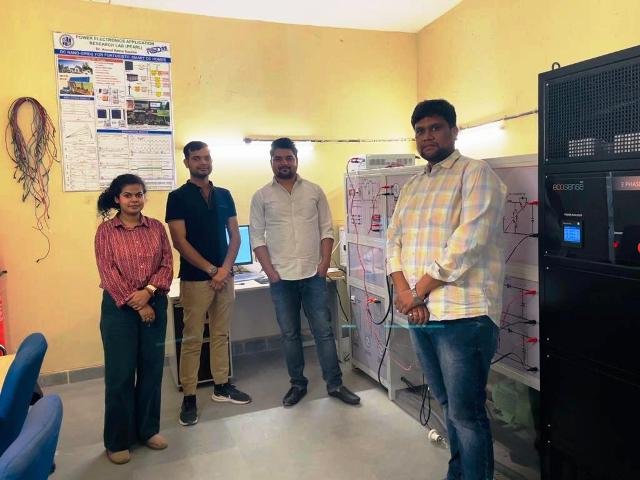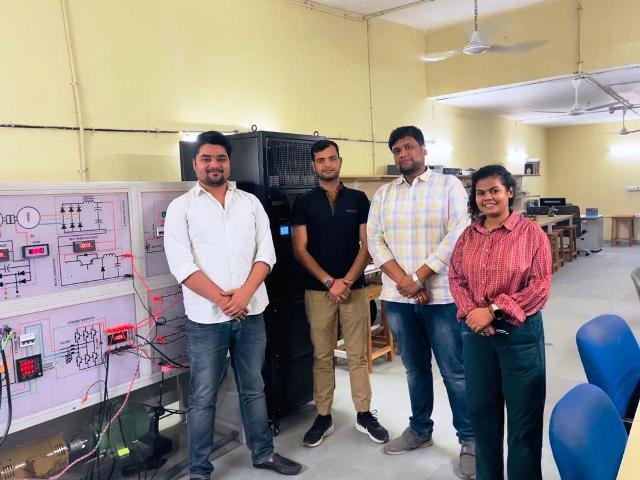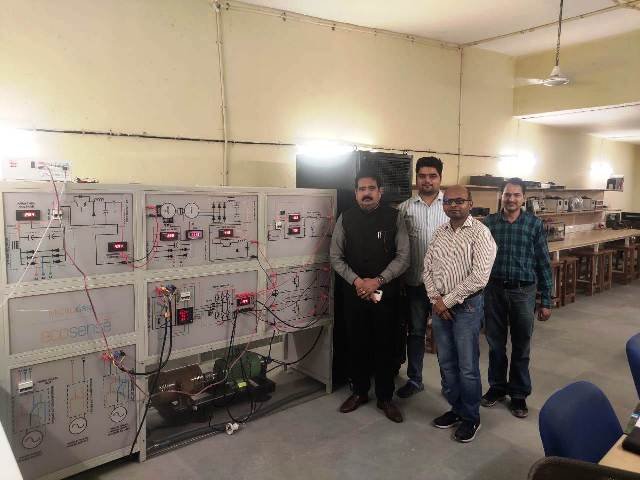Ecosense installed Hybrid AC/DC Microgrid at NIT Delhi
Ecosense's installation of a Microgrid system at the Department of Electronics and Electrical Engineering, NIT Delhi showcases their commitment to delivering advanced renewable energy solutions.

Ecosense's installation of a Microgrid system at the Department of Electronics and Electrical Engineering, NIT Delhi showcases their commitment to delivering advanced renewable energy solutions.
Ecosense's
installation of a Microgrid system at the Department of Electronics and
Electrical Engineering, NIT Delhi showcases their commitment to delivering
advanced renewable energy solutions. By incorporating various components like
PV Emulator, Wind Turbine Emulator, Fuel Cell, Battery bank, AC and DC Loads,
the Microgrid lab offers researchers the opportunity to investigate and
understand the performance of microgrid systems in diverse scenarios.
The PV Emulator
simulates the behaviour of solar photovoltaic panels, allowing researchers to
analyse how the microgrid responds to solar energy generation. The Wind Turbine
Emulator, on the other hand, replicates the characteristics of a wind turbine,
enabling the study of wind energy integration and its impact on the microgrid
system.
Additionally,
the presence of a Fuel Cell and Battery bank facilitates energy storage within
the microgrid. This feature allows researchers to explore the dynamics of
energy storage, including charging and discharging processes, and evaluate the
system's overall efficiency and stability.
Moreover, the
availability of both AC and DC Loads enables researchers to connect different
types of loads to the microgrid system and observe how they influence its
behaviour. This comprehensive setup allows for a thorough analysis of the
microgrid's performance and behaviour, ensuring a better understanding of its
operational dynamics.
The modular and
scalable design of the system makes it easy to add more energy sources, while
requiring very little space for installation. Ecosense's Microgrid lab is a
grid-connected setup where the output of the DC Microgrid is connected to the
main AC grid via a Voltage Source Converter (VSC). The system can also be
configured to work as a standalone setup, providing researchers with the
flexibility to conduct experiments according to their specific needs.
The Microgrid
lab offers a variety of research options, from the ability to track the
torque-speed and power-speed characteristics of a wind turbine at different
wind speeds and pitch angles, to the comparative analysis of different PV
panels using a PV emulator. The system allows for the continuous sensing of
grid-side voltage and currents, providing an opportunity to implement advanced
control algorithms to control the behaviour as per grid conditions.
One of the key
advantages of the Ecosense Microgrid system is its modular and scalable design.
This allows for the addition of more energy sources as needed, making it easy
to expand the system to meet the changing needs of the campus over time. The
system is also rigorously tested and can work continuously without switching
off, providing a reliable source of research equipment for the university.
The Ecosense
Microgrid system requires very little space for installation, making it an
ideal solution for the limited space available on a university campus. In
addition, the system is designed for easy maintenance and comes with an
illustrated experiment manual detailing every wiring connection to be made.
This makes it easy for university staff to perform routine maintenance and
repairs without the need for extensive technical expertise.
The Microgrid
system installed at NIT Delhi is also an open-source system, allowing
researchers and innovators to reprogram, rewire, and revise the system to carry
out their research goals. The system provides an opportunity for researchers to
explore different control techniques for smart grid implementation, conduct a
reliability analysis of the Microgrid system, and investigate the use of
advanced energy management systems (EMS) to optimize the scheduling of energy
sources, storage, and loads.
With its global
outreach and commitment to promoting sustainable energy practices, Ecosense is
well-positioned to continue leading the way in the field of renewable energy
solutions. Its Microgrid lab at NIT Delhi serves as a testament to the
company's dedication to innovation and its mission to reduce carbon emissions
and promote a more sustainable future.
·
Ability to
track torque-speed and power-speed characteristics of a wind turbine at
different wind speeds and pitch angle.
·
Plotting
Cp-λ curve to show the turbine characteristics at a particular pitch angle.
·
Real time
tracking of λ could be utilized to track the optimal λ of a turbine.
·
Maximum
power point tracking opportunity based on the generated voltage and current
feedback.
·
Ability to
control DC link voltage using bidirectional converter in stand-alone mode.
·
Research
on Microgrid possible as the DC link can accommodate other renewable sources
such as PV.
·
Power flow
and quality supplied to the grid can be controlled and analysed.
·
Further
exploration of control techniques for smart grid implementation possible.
·
Continuous
sensing of grid side voltage and currents provide opportunity to implement
advanced control algorithms to control the behaviour as per grid conditions.
·
Implementing
different maximum power point algorithm in Wind Turbine Emulator system
·
Maintaining
minimum reactive power at inverter output to achieve unity power factor and
maximise the usable power generation.
·
Using
different differential equations to emulate different Wind Turbine models.
·
Implementing
Anti-islanding protection using fault detection at different loads
·
Comparative
analysis of different PV panels using PV emulator.
·
Series-parallel
behaviour of different PV panels could be analysed for both stand-alone and
grid connected systems.
·
Study the
buck and boost mode of operation of bidirectional converter in the battery
back-up system
·
Study
system performance with three renewable sources connected together to form a DC
micro grid with battery as the energy storage device.
·
Study
integration of DC micro-grid to the main AC grid using a 3-phase inverter.
·
Study the
operation of DC micro-grid under various load conditions by applying various DC
and AC loads.

After
successful installation of system, Product Demonstration is conducted. The
Product Demonstration was focused on how to efficiently utilize the system and
explaining the different features of the system.
Prof.
(Dr.) Ajay K. Sharma paid a visit to the Lab and appreciated the efforts of the
Department of Electrical and Electronics Engineering, NIT Delhi and Ecosense
Team for this lab installation.

The
faculty at NIT Delhi was overjoyed with the installation of the Microgrid Lab
and they are committed to make it even smarter with their ongoing research
activities.